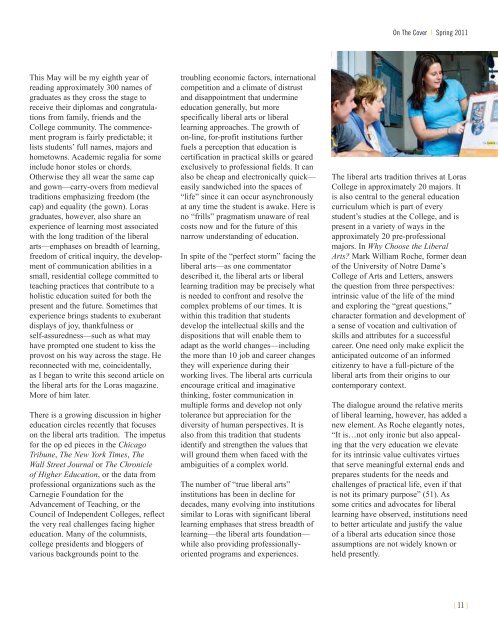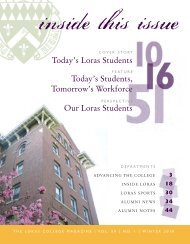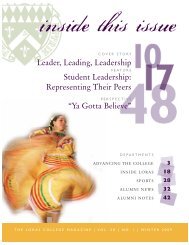THE LORAS COLLEGE MAGAZINE | VOL. 59 | NO. 1 | WINTER 2010
THE LORAS COLLEGE MAGAZINE | VOL. 59 | NO. 1 | WINTER 2010
THE LORAS COLLEGE MAGAZINE | VOL. 59 | NO. 1 | WINTER 2010
Create successful ePaper yourself
Turn your PDF publications into a flip-book with our unique Google optimized e-Paper software.
This May will be my eighth year of<br />
reading approximately 300 names of<br />
graduates as they cross the stage to<br />
receive their diplomas and congratulations<br />
from family, friends and the<br />
College community. The commencement<br />
program is fairly predictable; it<br />
lists students’ full names, majors and<br />
hometowns. Academic regalia for some<br />
include honor stoles or chords.<br />
Otherwise they all wear the same cap<br />
and gown—carry-overs from medieval<br />
traditions emphasizing freedom (the<br />
cap) and equality (the gown). Loras<br />
graduates, however, also share an<br />
experience of learning most associated<br />
with the long tradition of the liberal<br />
arts—emphases on breadth of learning,<br />
freedom of critical inquiry, the development<br />
of communication abilities in a<br />
small, residential college committed to<br />
teaching practices that contribute to a<br />
holistic education suited for both the<br />
present and the future. Sometimes that<br />
experience brings students to exuberant<br />
displays of joy, thankfulness or<br />
self-assuredness—such as what may<br />
have prompted one student to kiss the<br />
provost on his way across the stage. He<br />
reconnected with me, coincidentally,<br />
as I began to write this second article on<br />
the liberal arts for the Loras magazine.<br />
More of him later.<br />
There is a growing discussion in higher<br />
education circles recently that focuses<br />
on the liberal arts tradition. The impetus<br />
for the op ed pieces in the Chicago<br />
Tribune, The New York Times, The<br />
Wall Street Journal or The Chronicle<br />
of Higher Education, or the data from<br />
professional organizations such as the<br />
Carnegie Foundation for the<br />
Advancement of Teaching, or the<br />
Council of Independent Colleges, reflect<br />
the very real challenges facing higher<br />
education. Many of the columnists,<br />
college presidents and bloggers of<br />
various backgrounds point to the<br />
troubling economic factors, international<br />
competition and a climate of distrust<br />
and disappointment that undermine<br />
education generally, but more<br />
specifically liberal arts or liberal<br />
learning approaches. The growth of<br />
on-line, for-profit institutions further<br />
fuels a perception that education is<br />
certification in practical skills or geared<br />
exclusively to professional fields. It can<br />
also be cheap and electronically quick—<br />
easily sandwiched into the spaces of<br />
“life” since it can occur asynchronously<br />
at any time the student is awake. Here is<br />
no “frills” pragmatism unaware of real<br />
costs now and for the future of this<br />
narrow understanding of education.<br />
In spite of the “perfect storm” facing the<br />
liberal arts—as one commentator<br />
described it, the liberal arts or liberal<br />
learning tradition may be precisely what<br />
is needed to confront and resolve the<br />
complex problems of our times. It is<br />
within this tradition that students<br />
develop the intellectual skills and the<br />
dispositions that will enable them to<br />
adapt as the world changes—including<br />
the more than 10 job and career changes<br />
they will experience during their<br />
working lives. The liberal arts curricula<br />
encourage critical and imaginative<br />
thinking, foster communication in<br />
multiple forms and develop not only<br />
tolerance but appreciation for the<br />
diversity of human perspectives. It is<br />
also from this tradition that students<br />
identify and strengthen the values that<br />
will ground them when faced with the<br />
ambiguities of a complex world.<br />
The number of “true liberal arts”<br />
institutions has been in decline for<br />
decades, many evolving into institutions<br />
similar to Loras with significant liberal<br />
learning emphases that stress breadth of<br />
learning—the liberal arts foundation—<br />
while also providing professionallyoriented<br />
programs and experiences.<br />
On The Cover | Spring 2011<br />
The liberal arts tradition thrives at Loras<br />
College in approximately 20 majors. It<br />
is also central to the general education<br />
curriculum which is part of every<br />
student’s studies at the College, and is<br />
present in a variety of ways in the<br />
approximately 20 pre-professional<br />
majors. In Why Choose the Liberal<br />
Arts? Mark William Roche, former dean<br />
of the University of Notre Dame’s<br />
College of Arts and Letters, answers<br />
the question from three perspectives:<br />
intrinsic value of the life of the mind<br />
and exploring the “great questions,”<br />
character formation and development of<br />
a sense of vocation and cultivation of<br />
skills and attributes for a successful<br />
career. One need only make explicit the<br />
anticipated outcome of an informed<br />
citizenry to have a full-picture of the<br />
liberal arts from their origins to our<br />
contemporary context.<br />
The dialogue around the relative merits<br />
of liberal learning, however, has added a<br />
new element. As Roche elegantly notes,<br />
“It is…not only ironic but also appealing<br />
that the very education we elevate<br />
for its intrinsic value cultivates virtues<br />
that serve meaningful external ends and<br />
prepares students for the needs and<br />
challenges of practical life, even if that<br />
is not its primary purpose” (51). As<br />
some critics and advocates for liberal<br />
learning have observed, institutions need<br />
to better articulate and justify the value<br />
of a liberal arts education since those<br />
assumptions are not widely known or<br />
held presently.<br />
{ 11 }





![Printable Annunal Report [pdf] - www.loras.edu - Loras College](https://img.yumpu.com/4580579/1/190x245/printable-annunal-report-pdf-wwwlorasedu-loras-college.jpg?quality=85)
